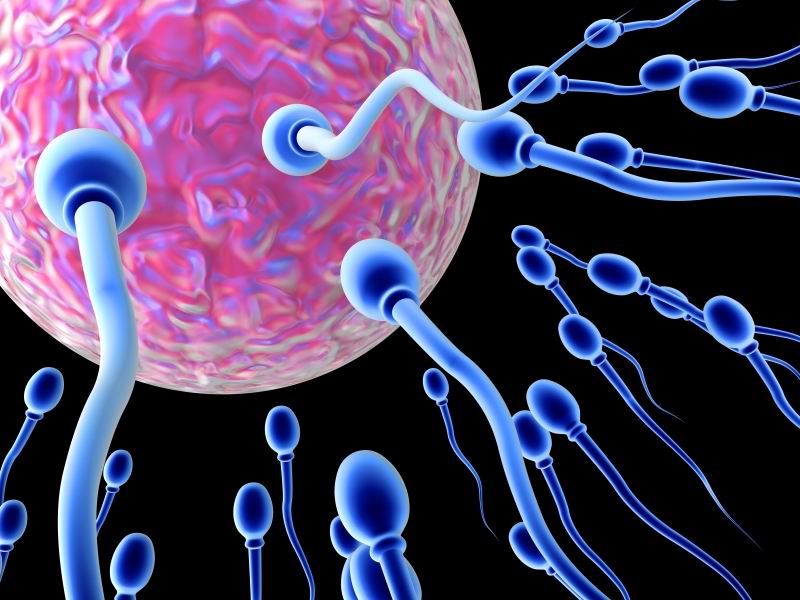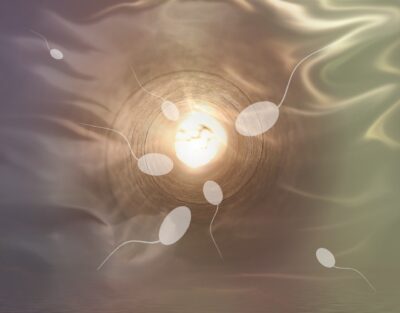
Timing of Sexual Intercourse in Relation to Ovulation — Effects on the Probability of Conception, Survival of the Pregnancy, and Sex of the Baby
Allen J. Wilcox, M.D., Ph.D., Clarice R. Weinberg, Ph.D., and Donna D. Baird, Ph.D.
N Engl J Med 1995; 333:1517-1521December 7, 1995DOI: 10.1056/NEJM199512073332301
Conception can occur only near the time of ovulation. However, the number of fertile days before or after ovulation is uncertain. Estimates range from 2 days per menstrual cycle1,2 to 10 days or more.3,4 Other issues related to fertility also remain unsettled. For example, what is the frequency of sexual intercourse that will maximize a couple’s chance of achieving a pregnancy? If intercourse is poorly timed or infrequent, will sperm that have aged in the female reproductive tract before ovulation produce a less viable conceptus? Can a couple influence the sex of their baby by timing their intercourse in relation to ovulation? We addressed these questions in a prospective study of healthy women who were trying to conceive.
Methods
Study Design
The North Carolina Early Pregnancy Study was a prospective cohort study conducted to determine the risk of early loss of pregnancy among healthy women.5,6 From 1982 through 1985, we recruited from the local community 221 women who were planning to become pregnant. Women were excluded if they had a serious chronic illness or if they or their partners had a history of fertility problems. Ninety-six percent of the participants were white, and 71 percent were college-educated. Eighty percent were between the ages of 26 and 35, and one third were nulliparous.6 All the women who were enrolled gave their written informed consent, and our research protocol was reviewed and approved by the institutional review board of the National Institute of Environmental Health Sciences.
Details of the protocol have been published previously.5,6 Women collected specimens of first morning urine daily from the time they stopped using birth control until the eighth week of clinical pregnancy, or for up to six months if no pregnancy was clinically evident. At the time of urine collection, the women recorded whether or not they had had sexual intercourse or vaginal bleeding in the previous 24 hours. Intercourse that was recorded on a given morning was assumed to have occurred the previous day. Urine collection was complete for 98 percent of the days in the study.
Laboratory Methods
We used the urine specimens to monitor the ovarian steroid changes that accompany ovulation. Assays of estrone 3-glucuronide (a metabolite of estradiol) and pregnanediol 3-glucuronide (a metabolite of progesterone) were carried out by direct radioimmunoassay.7,8 For eight cycles with ambiguous results on radioimmunoassay, data were supplemented by immunofluorometric assays.9,10 The ratio of urinary estrogen metabolites to progesterone metabolites has been discussed by Royston as a way to identify the day of ovulation.11 We refined Royston’s algorithm, exploiting the rapid drop in the estrogen-to-progesterone ratio that signals the luteinization of the ovarian follicle.12 Using data on hormones from another study, we found that the day of ovulation selected by the algorithm was highly concordant with the peak urinary concentration of luteinizing hormone (which corresponds approximately with the day of ovulation13). Our data suggest that this method may be approximately equivalent in accuracy to methods based on the surge of serum luteinizing hormone.9
Pregnancy was identified in this study by the measurement of intact human chorionic gonadotropin (hCG) in urine with a highly sensitive and specific immunoradiometric assay.14 This assay was able to detect an increase in urinary hCG as early as six days after ovulation, at the expected time of implantation.
Serial Urinary Hormone Values in a Woman Trying to Conceive. shows the hormonal data from one of the participants. During her 19 weeks of participation, the woman in this example had two apparently normal menstrual cycles and then one in which a clinical pregnancy began. The increase in urinary pregnanediol 3-glucuronide in the latter part of each cycle indicates that ovulation took place during all three cycles. There is evidence in the first cycle of a conceptus that did not survive (indicated by the transient increase in hCG). Conception in the third cycle culminated in the birth of a healthy boy.
Statistical Analysis
If there were only one instance of sexual intercourse during each menstrual cycle, the timing of intercourse that led to conception would be obvious. However, there are usually several days on which intercourse is potentially responsible for any given conception (as was the case in Figure 1), a fact that complicates the estimation of the probability of conception on specific days.
In 1969, Barrett and Marshall proposed a method of estimating the daily probability of conception.15 Their model estimates the probability of conception associated with intercourse on specific days in relation to ovulation and implicitly assumes that the timing of intercourse is the only determinant of whether conception occurs. Schwartz et al. expanded this model by adding “cycle viability” as a component of the probability of conception.16 Cycle viability is based on all conditions other than the timing of intercourse that are necessary for conception. Conception cannot occur without, for example, the release of a healthy egg and adequate preparation of the endometrium for implantation. The expanded model allows for the occurrence of some nonviable cycles, but it assumes that in a viable cycle the effects of intercourse on different days are statistically independent. We have proposed a method17 for applying the model of Schwartz et al. that uses widely available statistical software (GLIM18) and allows adjustment for factors other than the timing of sexual intercourse. In the resulting model, the probability of cycle viability corresponds to the proportion of ovulatory menstrual cycles (those during which ovulation occurs) in which conception is potentially possible.
The Study Sample
A total of 221 women provided records for 708 menstrual cycles. In the subsequent hormone assays, five of these cycles were identified as double cycles (i.e., two apparently ovulatory cycles not separated by recorded menses). This may reflect a failure of the women to record an episode of menstrual bleeding or the occurrence of hormonal cycles without menstrual bleeding.19 Thus, 713 cycles were available for analysis. Pregnancy was detected chemically in 199 of these cycles.6,20 Forty-eight of the pregnancies ended within six weeks of the last menstrual period. The remaining 151 pregnancies lasted at least six weeks and were recognized clinically. In 15, the pregnancy was lost before birth; there was 1 molar pregnancy, 1 ectopic pregnancy, and 13 spontaneous abortions before 24 weeks of gestation. The remaining 136 pregnancies ended in live births.
Our analysis was restricted to menstrual cycles for which a day of ovulation could be identified. Five of the 713 menstrual cycles (<1 percent) were frankly anovulatory, with no increase in the urinary concentration of pregnanediol. A day of ovulation could not be identified for 48 other cycles (34 with missing data and 14 with irregular patterns of hormone production), leaving 660 cycles for which the day of ovulation could be specified (93 percent). For 35 of the 660 cycles (5 percent) either data on the timing of intercourse or data on urinary hCG concentrations were missing for crucial days. This left 625 ovulatory cycles in 217 women for the present analysis (88 percent of all cycles; 98 percent of the women). These 625 cycles included those in which conception occurred for 129 of the 136 live births (95 percent) and all 63 of the pregnancy losses.
Since one third of the conceptuses did not survive to delivery, the total probability of conception can be multiplied by two thirds to estimate the probability of conception leading to a successful pregnancy (assuming that the survival of the conceptus is independent of the timing of intercourse).
Results
Probability of Conception around the Time of Ovulation
The couples in this study had intercourse an average of once every three days, a frequency that makes it difficult in most pregnancies to attribute conception to intercourse on one particular day. As a preliminary exploration, we selected all 192 cycles in which conception occurred and examined the patterns of intercourse around ovulation to identify the range of fertile days. In every cycle in which conception occurred, there was intercourse at least once during the six consecutive days that ended with the day of ovulation. There was no shorter span of days that included intercourse in every cycle. Conversely, there were 31 cycles (of a total of 625) in which there was no intercourse during this six-day interval, and none resulted in conception.
As a preliminary estimate of the chance of conception on individual days, we identified all the cycles in which intercourse occurred on only a single day during the six-day period. On the basis of these 129 cycles (21 percent of the total), the proportion with a detected pregnancy ranged from 0.08 on the first day of the six-day period to 0.36 on the sixth day (the day of ovulation)
For all 625 cycles, we applied our statistical model to estimate the chance of conception on each of the six days in the fertile period. These probabilities ranged from 0.10 to 0.33 — figures similar to the proportions for the single-day cycles (Figure 2). Probability of Conception Based on 129 Menstrual Cycles in Which Sexual Intercourse Occurred on Only One Day during the Six-Day Interval Ending with the Day of Ovulation and on All 625 Cycles.. The proportion of ovulatory cycles potentially able to produce a pregnancy (cycle viability) was estimated to be 0.37 (95 percent confidence interval, 0.31 to 0.48).
We added one day to the six-day period in each direction and repeated the analysis. The estimated probability of conception was zero on both marginal days. However, we cannot exclude a probability of conception of up to 12 percent on either the seventh day before ovulation or the day after ovulation (95 percent confidence interval, 0 to 0.12).
If the cycle is viable (i.e., if conception is possible), the model assumes that each day of intercourse in the six-day period contributes independently to the probability of pregnancy. Thus, daily intercourse would produce the highest probability of conception (0.37). The estimated rate of conception falls to 0.33 with intercourse that averages every other day (assuming no special timing with regard to ovulation). At lower frequencies of intercourse, the rate of conception drops more rapidly; untimed intercourse averaging once per week would produce a 0.15 chance of conception per cycle. Considering live births only (which accounted for two thirds of the conceptions), the approximate probability would be 0.25 with daily intercourse, 0.22 with intercourse every other day, and 0.10 with weekly intercourse.
The assumption that each day on which intercourse occurs makes an independent contribution to conception is open to question. Frequent intercourse might decrease the potency of semen — for example, by depleting the number or quality of sperm.21-23 As a rough test of this hypothesis, we sorted cycles according to the number of days on which intercourse occurred during the six-day period. If frequent intercourse decreases the fertilizing capacity of sperm, then the observed number of pregnancies initiated in cycles with more frequent intercourse should be less than that predicted by the combined day-specific probabilities. Similarly, cycles with intercourse on only one day should produce more pregnancies than predicted. Predicted and Observed Numbers of Pregnancies, According to the Number of Days when Sexual Intercourse Occurred during the Six-Day Interval Ending with the Day of Ovulation. shows the predicted and observed numbers of pregnancies for each frequency of intercourse (from none to daily) during the six-day period. The model fits well across the range of values for the frequency of intercourse, with no overall trend toward lower fertility with a higher frequency of intercourse.
Age of Sperm and Survival of the Pregnancy
It has been speculated that fertilization by old sperm (i.e., sperm that remain in the female reproductive tract for a relatively long time before fertilization) produces damaged conceptuses and leads to loss of pregnancy.24 In order to address this question, we arranged cycles during which conception occurred according to the number of days between ovulation and the most recent instance of intercourse; we then divided the conceptions according to whether or not they resulted in live birth. Only 6 percent of the conceptions could be firmly attributed to fertilization by sperm three or more days old. The pattern of intercourse in relation to ovulation was similar overall for conceptions that ended in fetal loss and those that ended in live birth . Frequency Distribution of Live Births and Pregnancy Losses, According to the Time of the Most Recent Instance of Sexual Intercourse before Ovulation during the Cycle when Conception Occurred.).
Timing of Intercourse and the Sex of the Baby
Some have argued that the timing of intercourse in relation to ovulation can influence the sex of the conceptus.25 We tested for any association between timing and the sex of the infant by dividing live births according to whether the babies were boys or girls and again plotting the distribution of cycles during which conception occurred according to the day of most recent instance of intercourse Frequency Distribution of Live-Born Boys and Girls, According to the Time of the Most Recent Instance of Sexual Intercourse before Ovulation during the Cycle when Conception Occurred.). There were no systematic differences between the patterns of intercourse that produced boys and the patterns that produced girls.
Discussion
Despite its great practical importance, the number of fertile days during the menstrual cycle has been difficult to specify. Some authors have calculated a theoretical period of two fertile days, based on estimates of the survival of sperm and eggs.1,2 A multicenter study by the World Health Organization estimated that there are 10 presumably fertile days per cycle, on the basis of the characteristics of the cervical mucus.3 Records made by British couples using natural family planning in the 1960s show a 13-day period during which pregnancies were apparently conceived.11 Barrett and Marshall were the first to use these data to estimate a fertile period15; the data were reanalyzed by Schwartz et al. in 198016 and supplemented and reanalyzed by Royston in 1982.11 The day of ovulation was estimated from women’s records of their basal body temperatures; this method is subject to considerable error.26 Moreover, the women had been asked to record the days on which intercourse occurred but not days without intercourse. Errors of omission could lead to the misattribution of conception to intercourse on days far from ovulation, a fact that may help explain the very broad fertile period calculated from these data.
Our data suggest that the fertile period lasts about six days and ends on the day of ovulation. The rapid drop in the probability of conception after ovulation suggests a short survival time for ova, or perhaps a change in the cervical mucus after ovulation that obstructs the entry of new sperm. In contrast, the finding that there are five fertile days before ovulation indicates that sperm retain their ability to fertilize an ovum for up to five days in the female reproductive tract. This is consistent with indirect observations regarding the survival of sperm. Motile sperm have been found in the cervical mucus for seven or more days after insemination,27,28 and sperm retain the capacity to fertilize human ova in vitro after five days at room temperature.29
Some couples are advised to maximize their chance of pregnancy by timing their intercourse to coincide with ovulation (for example, using kits to detect the surge of luteinizing hormone). If the probability of conception declines soon after ovulation, couples who abstain from intercourse until they have evidence of ovulation may miss earlier opportunities for conception.
Even with daily intercourse, most ovulatory menstrual cycles (an estimated 63 percent in our study) may be incapable of producing a conception. Factors besides intercourse apparently have a strong role in determining fertility. The model we have used assumes that the probability of a viable cycle is evenly distributed among couples, although couples in fact tend to vary in the proportion of cycles that are viable.30 The probability of conception could be higher or lower for specific couples. In particular, couples who have been trying to conceive for six months or more (longer than the women in our study) will, on average, have lower cycle viability and thus a lower probability of conception.
Frequency of Intercourse and the Probability of Conception
Closely spaced ejaculations reduce the sperm count, the concentration of sperm, and the percentage of sperm that are motile.21-23 Thus, frequent ejaculation could theoretically reduce the potency of subsequent batches of sperm. However, we found scant evidence of this phenomenon in this study. Our data provide no support for a recommendation that normal couples seeking pregnancy should limit the frequency of sexual intercourse.
Age of the Gamete and Survival of the Pregnancy
Some data on animals have suggested that fertilization by aging sperm may decrease the viability of the resulting conceptus.24 Studies in humans provide few data on this issue and little evidence that older sperm cause spontaneous abortions.31,32 We found no evidence for this association in our data, although only 12 conceptions could be attributed to sperm that were more than two days old. The question of the potential harm caused by aging sperm is likely to be resolved only by data from much larger cohort studies. The most informative would be studies of couples trying to avoid pregnancy by natural family planning, since accidental pregnancies among these couples are likely to result from intercourse at the extremes of the fertile interval.24
The fertilization of aging ova (that is, at some extended time after ovulation) may be more harmful to the conceptus than fertilization by aging sperm.24 We cannot evaluate the risk to conceptions involving old ova because no pregnancies in our study could be attributed to intercourse after the day of ovulation.
Timing of Intercourse and the Sex of the Baby
Various claims have been made for methods of selecting the sex of the infant through the deliberate timing of intercourse. Shettles and Rorvik recommend that couples who wish to have a boy should time their intercourse to coincide with ovulation, with up to 85 percent success claimed for the selection of boys and 80 percent for the selection of girls.25 In contrast, Zarutskie et al. concluded in their review of the published literature that if there is any tendency, it is for more females than males to be conceived when coitus occurs close to ovulation.33 We previously reported a possible association between the sex of the baby and the length of the follicular phase.34 However, we found no association between the sex of the baby and the timing of intercourse in relation to ovulation. We conclude that the deliberate timing of intercourse around the day of ovulation has no practical value in sex selection.
In summary, we have described the fertile days of the menstrual cycle for a group of healthy women. By analyzing data on the day of ovulation (identified by means of hormone assays of daily urine specimens) and daily records of sexual intercourse, we found that all conceptions resulted from intercourse that occurred during a six-day interval ending on the day of ovulation. The sex of the baby was not related to the timing of intercourse in relation to ovulation.
We are indebted to Dr. Paul Musey of Atlanta University, who supervised the steroid assays; to Drs. Del Collins of the University of Kentucky and James Kesner of the National Institute of Occupational Safety and Health; to the staff of the laboratory of Dr. Robert Canfield at Columbia University, who performed the assays for human chorionic gonadotropin under the supervision of Drs. John O’Connor and Glenn Armstrong; to Joy Pierce, who directed the original field study and subsequently managed the storage and shipment of the 27,000 urine specimens; to Dr. D. Robert McConnaughey, who created data files and graphics; and to Drs. Gertrud Berkowitz, Pierre Buekens, Glinda Cooper, Curtis Eshelman, Ronald Gray, Paige Hornsby, David Katz, Ruth Little, Andrew Rowland, Dale Sandler, David Savitz, Katherine Shea, and Joe Leigh Simpson for their valuable comments on previous drafts of this paper.
Source Information
From the Epidemiology Branch (A.J.W., D.D.B.) and the Statistics and Biomathematics Branch (C.R.W.), National Institute of Environmental Health Sciences, Research Triangle Park, N.C.
Address reprint requests to Dr. Wilcox at the Epidemiology Branch, NIEHS, Research Triangle Park, NC 27709



